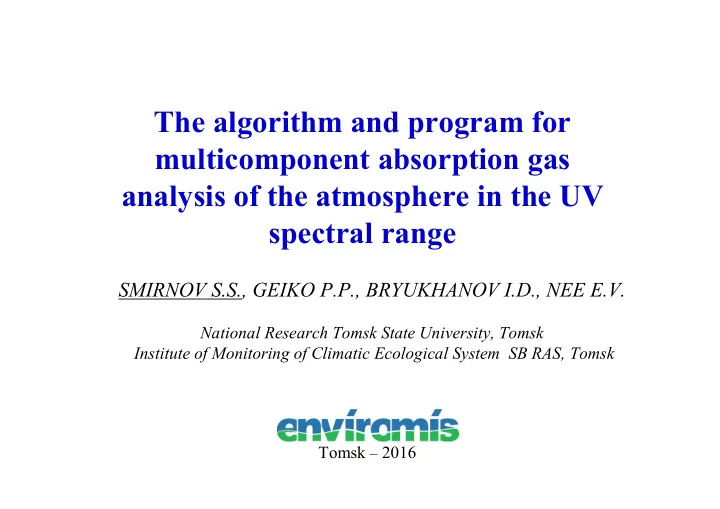

The algorithm and program for multicomponent absorption gas analysis of the atmosphere in the UV spectral range SMIRNOV S.S., GEIKO P.P., BRYUKHANOV I.D., NEE E.V. National Research Tomsk State University, Tomsk Institute of Monitoring of Climatic Ecological System SB RAS, Tomsk Tomsk – 2016
Relevance Due to with the global environmental problem of air pollution [1], increased interest in the development of methods and instruments for the remote (without sampling) of chemical analysis of the atmosphere. In recent years, differential optical absorption spectroscopy (DOAS) is regarded as an effective method for the detection of atmospheric pollutants. Fig.2 – Sources of air pollution. ____________________________________________________________________________________________________ 2 1. The air quality in major cities of Russia for 10 years (1998-2007): Analytical overview. St.P.: CNIT «Asterion», p. 133, 2009.
Factors determining of light extinction Passing through the open atmospheric trace, the optical radiation is absorbed by all gas components and scattered by air molecules and aerosol particles. Fig.2 – Factors determining light extinction in the atmosphere. Beer – Lambert – Bouguer law [2]. J I ( ) A ( ) I ( ) exp{ L ( ( ) C ( ) ( ))} 0 j j M R j 1 – incoming radiation, – absorption cross-section, L – optical path, ( 0 ) I ( ) C – concentration of the absorber, M , – extinction coefficients Mie and Rayleigh. R ________________________________________________________________________________________________ 2. Platt,U., and Stutz,J. Differential Optical Absorption Spectroscopy: Principles and Applications, Springer-Verlag, 3 BerlinHeidelberg, ISBN: 978-3-540-21193-8.pp.1366–5901, (2008).
The DOAS Principle Fig.3 – Separation the differential part of the absorption cross-section (left) and absorption cross- section of sulfur dioxide (right). High frequency structure – imprints of gases: hf lf ( ) ( ) ( ) hf lf hf lf ( ) ( ) C L ( ( ) ( )) C L ( ) C L ( ) C L hf lf ( ) ( ) ( ) 4
Differential optical depth To define relative optical depth filtering procedures • Polynomial fit (commonly used p = 3 ÷ 7) • Spline approximation • Digital smoothing • Fourier transform I ( ) J p 0 ( ) ln L ( ) C b j j p I ( ) j 1 p b – polynomial p – order. p p p J Fig.4 – The principle of separation I ( ) I ( ) hf hf o o ( ) ln ln ( ) C L attenuation spectrum and the j j I ( ) I ( ) j 1 absorption spectrum of the gas, hf lf – differential part of by filtering procedures. j j j absorption spectrum of the gas, I – smooth ( ) o component of the received spectral attenuation. 5
Differential optical depth hf hf Case1: One absorber С ( ) / ( ) L Case 2: More gases with not interfering structured absorption cross section. Case 3: More gases with interfering abs.cs. System of linear equations: J hl hf S ( ) ( ) C L k j k j k j j 1 k=1,n; n - the number of discrete of signal samples in respect to concentrations C j of absorbers along the optical path L 6
The system DOAS Source of radiation - UV radiation the xenon lamp of high pressure. Coaxial telescope - optical scheme of the telescope - transmitting and receiving channels. Retroreflector (angel reflector) – reflects radiation falling on it and is fastened on any support on the remote end of air path. Fig. 5 – The system DOAS. Monochromator-Spectrograph is intended for decomposition of radiation in spectrum. Diode array with the electronic unit is used for detection of optical radiation across a broad spectral range. Fig. 6 – Experimental setup for DOAS spectrometer. 7
The processing of received spectrum Рис.7 – The processing the received spectrum. 8
The processing of absorption spectrum Рис.8 – Separation the differential part of the absorption spectrum of ozone. 9
Fit procedure Рис.9 – Fit procedure differential parts. 10
Measurement of ozone Рис.10 – Two-hour course of ozone concentrations. 11
Summary The mathematical formalism of the method of differential optical absorption spectroscopy is presented. The initial data of temperature and pressure for calculation of transmittance of molecular oxygen, the optical path length in the atmosphere and the ratio of exposures reference absorption spectrum and the spectrum of the signal received from the atmosphere are established. As a result of fit, nonlinear least squares method, the theoretical absorption cross sections of the gas components of the atmosphere are obtained based on the instrumental function of the spectral instrument, to differential of the experimental spectrum of the received signal attenuation, calculation of concentration values of gas mixtures and measurement errors are produced. The program allows to: choose an informative interval for each target gas and the degree of interpolation and also the possibility of adding new gases. The program is universal as can be applied not only to the ultraviolet region, but for the entire optical range as a whole. 12
Thanks for attention Smirnov Sergey SSSmirnov@sibmail.com 13
The algorithm of active DOAS measurement Fig.5 – Flowchart of a typical active DOAS measurement and evaluation procedure. 14
Recommend
More recommend